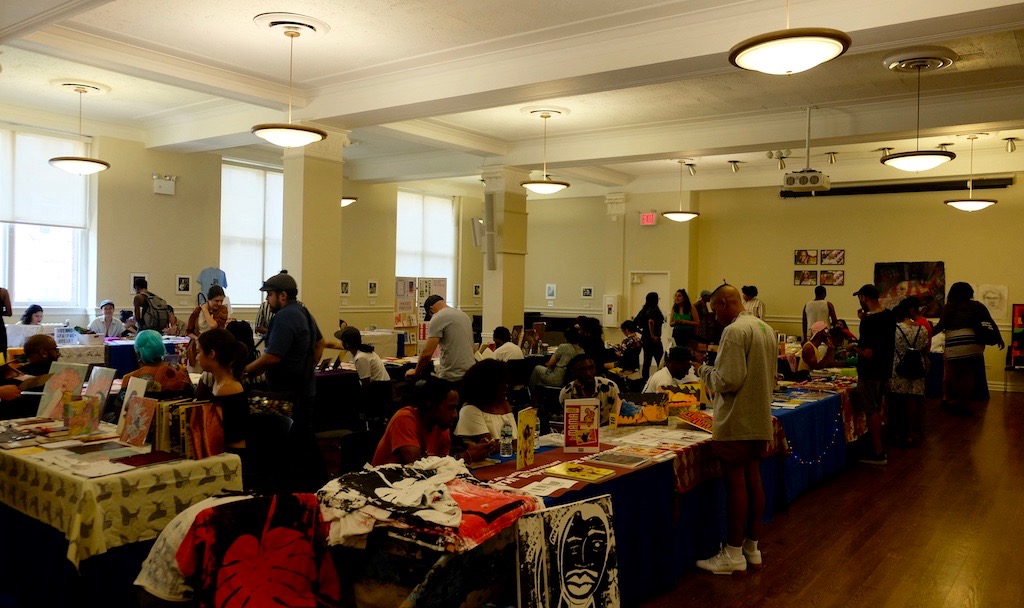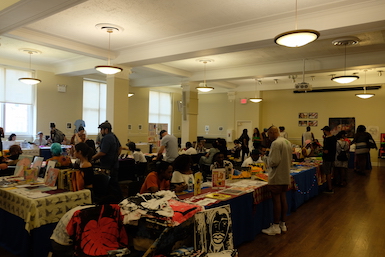[ad_1]

Vendors at the Brown Paper Zine and Small Press Fair.
COURTESY DEVIN N. MORRIS
Two weekends ago, Barnard College in Upper Manhattan played home to a spirited congregation of art-book vendors, some at tables with sparkly tablecloths or LED lights or a pillow shaped like a long green snake—and all assembled for the second annual Brown Paper Zine and Small Press Fair. Conceived by 3 Dot Zine founder Devin N. Morris and presented in collaboration with the Studio Museum in Harlem’s artist-project initiative “inHarlem,” the fair showcased some 35 vendors of work by small upstart presses in addition to talks and workshops to attend.
Like 3 Dot Zine—a publication devoted to the experiences of “black, brown, and marginalized bodies”—other presenters fit into a framework that the Brown Paper fair identified as “an environment where the creative efforts of black artists and artists of color working in self-publishing and printed mediums are exposed and proliferated.” Some zines looked like time capsules, with artists’ scrawls and handwriting from old dairies. Many were stapled together in forms that ranged from a few pages to much longer in length. Titles ran the gamut: Deadass Tho NYC (“New York City’s friendly neighborhood art bodega”), Townies, Feeling Wintered, Bastard (for “Being Accomplished at Selfless Tasks and Righteous Deeds”), Very Black and Very White.
In the DIY spirit shared throughout the fair, Jay Stone, the founder and editor of The Experience Magazine, said he wanted to combat the “flood of bad messaging” in representations of black people and black culture. Instead of waiting around for mainstream publications like Complex and the Fader, Stone said, time would be better spent creating what he deemed “good propaganda.” Work by other presenters featured the same kind of yearning to reclaim contested narratives in the interest of freedom for expression, freedom for thought, and freedom for people to be themselves.

Lizania Cruz’s We the News.
SHIRLEY NWANGWA
In the talks program, photographers (Elliott Jerome Brown Jr., Maria Jose, and Jamal Lewis) discussed image literacy, while Joseph Cullier, resident artist at the experimental art school The Black School: Harlem, held a paper-folding workshop. Another talk featured two archivists: Shawn(ta) Smith-Cruz, of the Lesbian Herstory Archives, and Steven Fullwood, formerly of the New York Public Library’s Schomburg Center for Research in Black Culture. Smith-Cruz said that established presses and institutions have been haunted by “a legacy of not [having] a place for us.” Samples of historical zines that worked against that, like Black Lesbians in the 1970s and Before, were passed around the room.
Over the course of the weekend, Morris, the fair founder, occasionally interrupted music played over the PA (Frank Ocean, Tierra Whack, Beyoncé) to announce more talks and a poetry reading (by Rami Karim, Justin Allen, Joey De Jesus, and Anaïs Duplan). Outside, an installation was set up beside a pristine piece of lawn: Lizania Cruz’s We the News, a wooden newsstand specially constructed to hold reading material chronicling stories of black migrants. On an array of colored papers were stories drawing on interviews that Cruz had done with immigrants from countries like Haiti, Jamaica, Saint Lucia, Ghana, and Liberia, all to present a sort of “what if?” scenario in which immigration stories would be told solely from the perspective of immigrants. One of the papers boasted a headline that resonated: “The Land of Opportunity: Conversations on Sacrifice & Survival.”
[ad_2]
Source link

